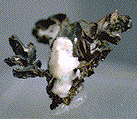

- Chemistry: Ag2Hg3, Silver Mercury (silver amalgam)
- Class: Native Elements
- Subclass: Native Metals
- Uses: A very very minor ore of silver and mercury and as mineral specimens.
Specimens
Alloys such as moschellandsbergite are classified as elements despite the fact, that in chemical reality, they are compounds! Moschellandsbergite like other alloys have metallic bonds that are very similar to the more pure metallic elements and are thus classified in the Native Elements Class.
PHYSICAL CHARACTERISTICS:
- Color is silver-white to gray.
- Luster is metallic.
- Transparency: Specimens are opaque.
- Crystal System is isometric.
- Crystal Habits include small rhombic dodecahedral crystal and globular masses.
- Cleavage is not seen.
- Fracture is conchoidal.
- Hardness is 3.5
- Specific Gravity is 13.6 - 13.7 (well above average, even for a metallic mineral)
- Streak is gray.
- Associated Minerals include mercury, calomel, cinnabar and other mercury minerals.
- Notable Occurrences are limited to the type locality at Landsberg (formerly Moschellandsberg), Obermoschel, Rhineland-Pfalz, Germany.
- Best Field Indicator is crystal habit, color, locality and density.







